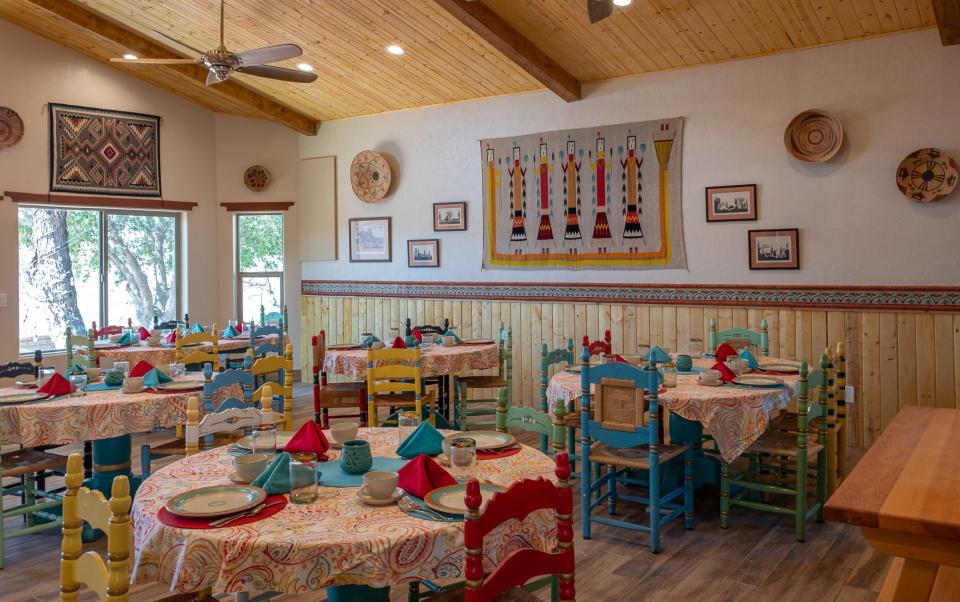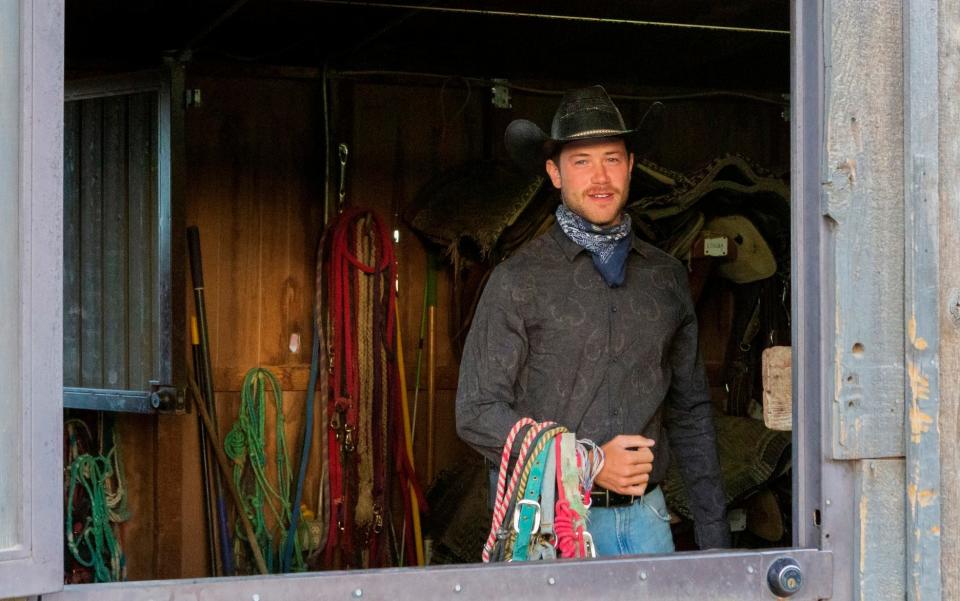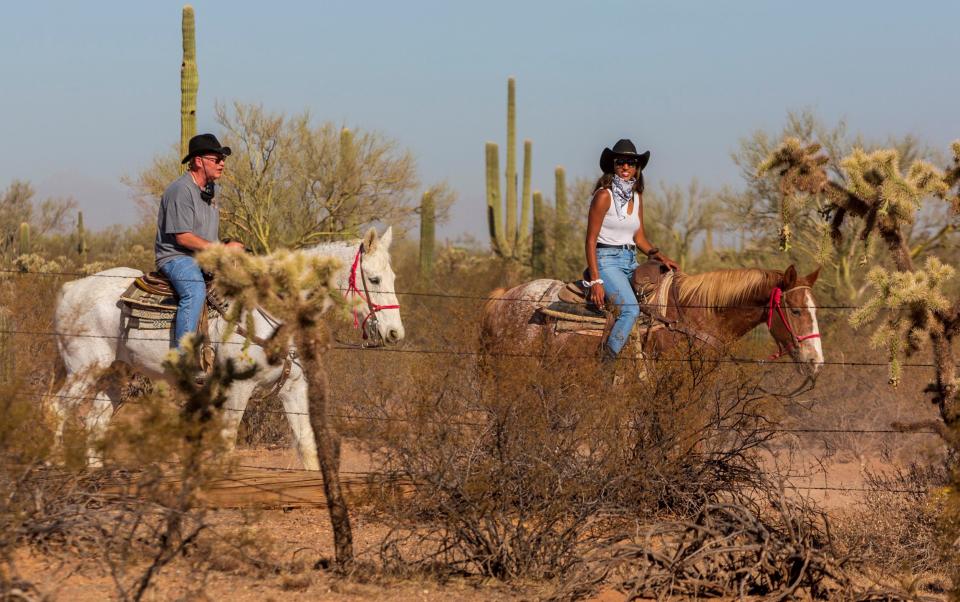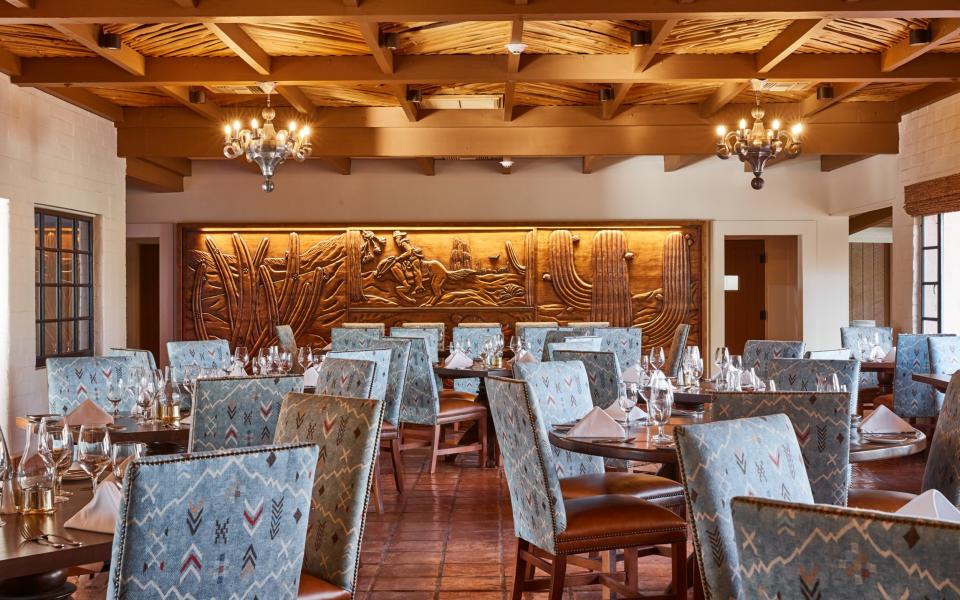On the trail of the Dude Ranch – an American icon under threat

One hundred horses and a lone donkey clattered from the corral. Behind them, cottonwood trees burned egg-yolk yellow and the mountains blurred to silhouettes. Hooves drummed and dust scattered. I had been promised a spectacle and this was it.
Each day before dusk, at Patagonia’s Circle Z Ranch, the herd runs towards the night pasture in a thundering sunset stampede. It’s a highlight of the daily schedule at this century-plus-old ranch – one of the eight historic properties on the newly designated Arizona Dude Ranch Heritage Trail.
The “dude ranch” or “guest ranch” grew as a concept in the late 1800s, as wealthy folks from the eastern United States and Europe were lured to the great expanses of the American West – from Wyoming, to Colorado and Arizona. Savvy ranchers – who made a hard, dust-coated living running cattle – soon realised they could earn extra cash by hosting affluent travellers. And so the guest ranch was born.
Fast-forward more than a century and sprawling guest ranches remain stitched into the titanic landscapes of the West. So the new trail – an initiative by the State of Arizona that links up the oldest of these precious properties – serves to safeguard a vestige of Western history.
“We get busier and busier every year,” said Diana Nash, co-owner of Circle Z Ranch, as we relaxed in the snug cantina warmed by an open fire. I was spending a few nights here, based in the spacious Lucia’s Suite with its pillowy king bed and views down to the corral. Circle Z has been in the Nash family since 1976 and, given it was founded back in 1926, it’s the oldest continuously operating dude ranch in the state. “Dude ranches offer a way to share this lifestyle – of riding horses, of being out in open spaces. This is the original form of nature-based tourism,” she says.

The new trail, Nash said, also showcases the breadth of Arizona’s terrain. Sprucedale Guest Ranch is the trail’s northeasternmost property, nosing up the New Mexico border, knitted into skinny pine trees. Towards the centre of the state, in Mesa, Saguaro Lake Guest Ranch is characterised by its namesake lake and the serpentine Salt River. Then there’s western Rancho de Los Caballeros, which is sewn into cactus-studded plains that could have been plucked straight from a crackling cowboy flick.
Circle Z bumps up against the Sonoita Creek State Natural Area and the Coronado National Forest with some 200 miles of trails that beat into the wilderness – they vault over lazy Sonoita Creek and snake into mesquite-stitched mountains, all within kissing distance of the Mexican border. Nash explained that the land holds archaeological relics from Indigenous cultures, such as the Sobaipuri and Papago tribes, who once called these lands home.
The waters are also an oasis for migratory birds and the region is the northernmost home of species like the coati, a racoon-like creature common in South America.

But even more than the wild animals, the beloved horses (and Tony, the adopted donkey) are the lifeblood of this property. Much as they have from the ranch’s earliest beginnings, days here centre around the herd, unfolding with lengthy trail rides and finishing with dinners served family style and campfire sing-alongs (wrangler Kelly moonlights as a musician).
Yet the real beauty of today’s Circle Z Ranch is that it’s not much different to yesterday. “We don’t have to reinvent the wheel each year,” wrangler Alice called out behind her, as she guided me up a rugged mountain track the next day. I was riding Picante, a gentle, cinnamon-coloured horse, who carefully picked her way along the trail. “We already have it figured out.”
The trail’s finale proved Alice’s point. The ground bowed dramatically, revealing heart-in-mouth panoramas of the 265-acre manmade Patagonia Lake. Picante let out a thick whoosh of breath, as if she too were admiring the view.
But while dude ranches have both natural and historic value in spades, that doesn’t mean it’s an easy ride, as Russell True, president of White Stallion Ranch, explained during my visit. White Stallion sits some 80 miles north of Circle Z, in the saguaro-filled backcountry of Tucson.
After checking into a thoughtfully presented suite decked with wooden beams and Western-themed art, I sat with True on the patio, next to an adobe structure built around the turn of the century. The land here was homesteaded from 1936 and guest rooms were constructed in 1945, after the ranch was bought by a wealthy Chicago liquor-store magnate. Back then, White Stallion added to a rich jigsaw of Arizona dude ranches.

“Arizona had 338 dude ranches at one time,” True told me. “And of those 338, there were 127 within a one-hour circle of Tucson. When my parents bought this ranch in 1965, there were still 24 dude ranches of the 127 operating in Tucson. Now there are two. I’ve watched them shrink away.”
True primarily blames both the “explosive growth” of urban areas and the soaring price of land for this decline. The latter, he explained, is in part due to the pandemic, which saw rural land snapped up at an alarming rate, as people poured out of cities.
“You can’t run a dude ranch and have nowhere to go riding,” he said. “A dude ranch isn’t about riding around an arena.”
Happily, at White Stallion, land is bountiful. The ranch spreads over some 3,000 acres and brushes up against the border of Saguaro National Park, which is used for the property’s riding programmes. Trails zigzag among skyscraping saguaro cacti, which only grow within the Sonoran Desert.
True hopes that the trail will put Arizona’s dude ranches back on the map. “These dude ranches are an important part of our heritage,” he says. “The new trail is a way to talk about that.”
For a dude ranch to qualify for the trail, it must have been operational for at least 25 years; be spread over 1,000 contiguous acres; and offer activities such as horseback riding or working cattle-ranch experiences.
But while this heritage is vital (“horses, hats, hospitality, heritage, honesty and heart” are the six linchpins of dude ranching, according to True), he recognises the value in diversifying the activities at White Stallion.

“Some people just want to go fast down the trail; other people want to ride out leisurely and come upon a tray of wine and cheese,” he chuckled.
The wine and cheese rides (not to mention the beer and cheetos rides) are a hit with the guests, who can also enjoy pursuits such as rock climbing, jeep rides or an evening at the ranch’s private movie theatre. One afternoon, I switched saddles and zipped into the desert on a fat bike, whizzing past curious longhorn cows and teetering cacti in the shadow of Panther and Safford Peaks.

The offerings at upscale Rancho de los Caballeros – around an hour northwest of Phoenix, in Wickenburg – are equally varied. I arrived just after sunset and settled into a rustic-chic casita complete with a roaring fire and a giant tub. Dinner was at the ranch’s swish Main Dining Room, where my vegetarian request was accommodated with aubergine steak, buttery mash and sticky-sweet brussels sprouts. The following days unfolded in a whirl of archery, trap shooting and evenings by the roaring lobby fire – the ranch’s most recent hire was a “Director of Fun”.
“The modern dude ranch has evolved into something more multifaceted,” general manager George McGann told me one afternoon. Rancho de los Caballeros opened in 1948 and was run by the same family for 74 years, before recently coming under new ownership. “We’re more of a resort now; we have the golf course, we have the spa. You would never have found a spa in an old dude ranch.
“The horses are still our main attraction – people want to come here and put their cowboy boots and hats on – but we have a lot of diversity in our attractions and I think that’s what most people are looking for today”.

Later, I struck out into the Sonoran Desert for a final ride with wrangler Shelby Norris. Norris regaled me with one of the many legends surrounding the town’s founder, Henry Wickenburg – he purportedly launched a rock at a circling vulture and found fortune when the rock shattered to reveal veins of gold. She also identified abundant desert flora along the way: willowy palo verde and scalpel-sharp teddy-bear cholla, named for its deceptively fuzzy appearance. There were more saguaros too, their giant arms flexing towards a powder-blue sky.
As we rode, I was reminded of the real, pulsing heart of any dude ranch: America’s wild, legend-woven West and the chance to explore it on horseback.

Essentials
Jacqui Agate was a guest of the Arizona Office of Tourism (visitarizona.com).
Rancho de los Caballeros (+1 928 684 5484; anchodeloscaballeros.com) has double rooms from £248 including breakfast.
Circle Z Ranch (+1 520 394 2525; circlez.com) has double rooms from £1,269pp for a short stay from Sun–Thu, or week-long stays from £2,221pp including meals, horseback riding and all scheduled activities, plus tax and gratuity.
White Stallion Ranch (+1 520 297 0252; whitestallion.com) has double rooms from £316, including meals and horseback riding.
You can fly direct from London Heathrow to Phoenix with British Airways (britishairways.com) from £548 return.


